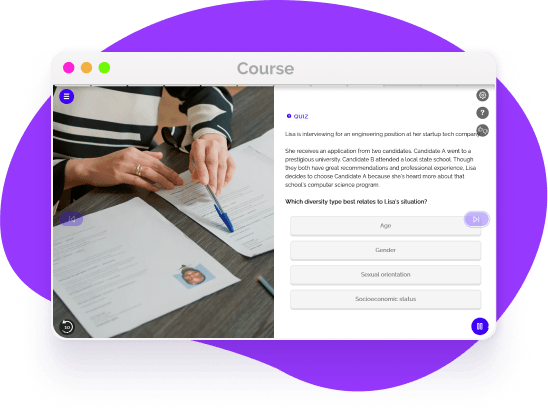Disability in the Workplace
Disability in the workplace is a topic of growing importance in today's society. From the Americans with Disabilities Act of 1990 to recent developments in workplace policies, disability has become an area of focus for employers and employees alike. The goal is to create an inclusive environment that allows individuals with disabilities to participate in the workforce without discrimination or prejudice.

Impact of Disability Awareness Training in the workplace
Disability awareness training in the workplace can have a positive impact on both employers and employees. It can help to increase understanding and acceptance of disabilities, create an inclusive and supportive environment, and improve the workplace experience for everyone. This can lead to better job satisfaction, improved employee morale, increased productivity, and reduced absenteeism. Additionally, it can help employers reduce their legal risks by ensuring compliance with disability laws and regulations.

Significance of Disability Awareness
Disability awareness helps to ensure that all employees, regardless of their abilities, are treated with respect and given opportunities to contribute to the success of the organization. It also allows employers to avoid potential legal issues and create a more inclusive atmosphere. Disability awareness also helps to create an environment where employees feel comfortable asking for any reasonable accommodations they may need to do their jobs. Disability awareness in the workplace is essential for creating a workplace that is free from discrimination and encourages everyone to reach their full potential.

Employees with disabilities pose a unique set of risks for employers in the workplace. The risks range from legal and financial implications to potential health and safety concerns. It is important for employers to understand these challenges so they can create an environment that is welcoming and supportive of all employees. Here are some challenges with employees with disabilities in the workplace may face:
Employers may not provide reasonable accommodations to disabled employees, or those accommodations may not meet the needs of the employee. This could include not providing an accessible workstation or wheelchair access. It could also include not providing the necessary technology or services to help employees with disabilities perform their duties. Additionally, employers may not provide the necessary training to employees on how to effectively interact with coworkers who have a disability. All of these can lead to a feeling of exclusion from the workplace and a lack of productivity from the disabled employee. Employers should ensure that reasonable accommodations are provided to all employees, regardless of their disability, to ensure an inclusive and safe workplace for everyone.
Disabled employees may face discrimination from coworkers, supervisors, and customers due to their disability. Discrimination against disabled employees can take many forms, including verbal or physical abuse, unfair treatment in terms of promotions, and unequal pay.
Employees may not be familiar with the specific needs of their disabled coworker, and thus may not be able to effectively interact with them. Unfamiliarity with disability can also lead to misunderstandings that could result in potential legal actions. In order to avoid potential liabilities, employers should be sure to provide adequate training to their employees on how to interact with disabled coworkers, as well as how to accommodate their specific needs. Training should also include how to provide reasonable accommodations, such as providing access to necessary equipment, making sure the workplace is safe and secure, and ensuring that the disabled employee has access to any necessary resources.

Rise of Disability in the workplace
The number of workers with disabilities in the workplace is steadily rising. This percentage has nearly doubled since the passage of the ADA, from 6.5% in 1995 to 12.2% in 2019. Employers are recognizing the importance of providing a workplace that is accessible to all workers, regardless of their disability status. The rise of employees with disabilities in the workplace demonstrates the value of recognizing and accommodating individuals with disabilities.
Myths Surrounding Disabilities in the workplace
Disabilities can be seen as a barrier to employment, and there are many myths surrounding disabilities in the workplace. These myths often prevent people with disabilities from finding meaningful and fulfilling work. Here are some myths to look out for:
Here are some myths to look out for:
- -
People with disabilities cannot work
- -
Employees with disabilities require more supervision
- -
Accommodations are too expensive
- -
Employees with disabilities will be liabilities

Help Prevent disability Discrimination through employee education
This chapter encourages employers to create an environment where employees with disabilities are treated with respect and dignity and where they can reach their full potential. By educating employees on the rights of individuals with disabilities and emphasizing the importance of creating an inclusive and accommodating environment, employers can help create a workplace that is free of disability discrimination.

Helping over 8,000 organizations create a safer, more productive workplace
This chapter introduces the role that disability plays in the diversity of the workplace that will be further detailed throughout the course.





















